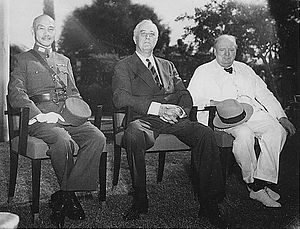SINGAPORE — In Singapore, where British Lieutenant General Arthur Percival surrendered 80,000 British-led troops to Japanese forces in February 1942, two men over on Sentosa Island have a chance to do something rather remarkable.
They have a chance to end the Second World War.
The problem of the Koreas is rooted in the torment and trauma of its occupation by Japan for 35 years prior to, and during, World War II. That occupation would ostensibly end if Japan lost the war.
Seventy-five years ago, in late 1943, with the war’s outcome still unknown and hardly certain, Allied leaders sat down in Cairo, and then again two days later in Tehran, and made decisions that would shape the postwar world. One of the questions before them was what to do with Korea once Japan was finally vanquished. Surprisingly, Churchill, Roosevelt, and Chiang Kai-Shek all ultimately agreed. “The aforesaid three great powers, mindful of the enslavement of the people of Korea, are determined that in due course Korea shall become free and independent,” read the statement in the Cairo Declaration. Stalin, who had not yet been consulted on this point, and who was not at war with Japan, nonetheless agreed a few days later in Tehran. It was very much in his interest to.
As Professor Jongsoo James Lee writes in The Partition of Korea After World War II: A Global History, “this decision at Cairo to defer Korea’s immediate independence and to allow for a Soviet role in a trusteeship thus gave Stalin practically a free hand to militarily occupy as much of Korea as he could depending on the future progress of the Red Army’s operations in Korea against Japan.”
At war’s end, Colonels Dean Rusk and Charles Bonesteel were tasked with quickly finding a dividing line in Korea to which the Soviets would agree. The Japanese would surrender to the Soviet and American forces north and south of that line, respectively. The 38th parallel, which later became the general area upon which the Military Demarcation Line (MDL) and the Demilitarized Zone (DMZ) are still established, became the basis of the problem which the summit tomorrow will hopefully begin to resolve. A problem which, to put it simply, was largely created in order to keep the Soviet Union committed to the war effort.
“In due course,” was the wrinkle in the Cairo Declaration’s promise of a “free and independent” Korea. A period of “trusteeship” was envisioned for Korea, while it was “taught” self-government (an oxymoron if ever there was one). The Korean people did not agree. The trusteeship broke down, the north invaded the south, and the two are, still as of today, at war. A war between two countries which themselves were created as spoils of a conflict largely beyond the control of the Korean people at the time.
Singapore today looks calm, as it usually does. People are going about their business, but are very much aware that history is on their doorstep. Sentosa Island, a short hop by road, subway, or even cable car from the main island of Singapore, bills itself as “The State of Fun.” Indeed, filled with beaches, casinos, upscale hotels, nature walks, and Universal Studios, Sentosa is a place to play. Even during this week, with President Donald Trump and Chairman Kim Jong-un ensconced in the Capella Hotel on the island, Sentosa wants the public to know it is open for business. As its website proudly proclaims, “Sentosa welcomes the DPRK-USA Singapore Summit delegates. While security measures will be implemented at selected areas of the island, it will be business as usual at our island’s various unique leisure offerings.”
Sentosa, though, is also home to a reminder of a more somber time, a time that hearkens back to the conflict that became the genesis for the issues Trump and Kim are here to discuss. Fort Siloso is the “only preserved coastal fort in Singapore,” built by the British in the 19th century. In 1942, as the Japanese came down the Malay Peninsula, the British used Siloso’s guns, albeit to little avail, to defend Singapore from the unexpected onslaught from the north.
The Fort Siloso Surrender Chambers show lets visitors relive the history from the 1942 invasion to the 1945 surrender. The website reminds its readers, “Before you leave, share a message of peace on the wall of poppies.”
Let us hope that Trump and Kim can share that same message tomorrow to a waiting world.

































